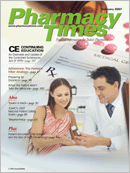A Pharmacist's Guide to OTC Therapy
Cough, Cold, and FluProducts
A multitude of nonprescription productsare currently available for alleviatingthe discomfort from the symptomsassociated with the common cold orthe flu, which include coughing, fever,chills, sore throat, nasal and chest congestion,sneezing, extreme fatigue, andaches. Product formulations are marketedas single-entity products or multisymptomrelief products (Table).
Although, traditional dosage formssuch as liquids, tablets, and capsulesare still widely used, product manufacturershave also developed formulationssuch as oral disintegrating tablets,chewable tablets, nasal swabs, nasalstrips, topical vapor patches, and dissolvablemedicated strips that areapplied to the tongue. Examples ofnew cold products include MucinexMini-Melts (Adams Respiratory TherapeuticsInc) for children, which areinnovative, quick-dissolving flavoredgranules that are easy to swallow;Zicam's Cold Rapid Melts with VitaminC (Matrixx Initiatives Inc); and Theraflu'sWarming Relief Syrups (NovartisConsumer Health Inc). In addition,McNeil Consumer Health Inc has a fewnew Tylenol Cold formulations.
These new formulations meet theneeds of many patients by providingconvenient administration, accuratedosing, and easy-to-use drug deliverysystems to accommodate busy schedules.Whereas formulations of coldproducts containing pseudoephedrineare available behind the counter, manymanufacturers have also added newformulations that contain phenylephrine instead of pseudoephedrine.
Selection of these products shouldbe based upon the patient's symptoms,concomitant medical conditions,and current drug regimen, as well aslifestyle and personal preferences.Pharmacists should always screen forpotential drug interactions, as well aspossible contraindications, and makerecommendations accordingly. It isimportant to ensure that patients arethoroughly counseled on the properuse of these products, especially productsfor the pediatric patient population.To ensure accuracy, patientsshould be reminded to always utilizecalibrated measuring devices whenadministering liquids. To prevent seriousmedication errors, parents andcaregivers should always be remindedto read labels prior to administration,since many infant drops are in concentratedform.
In addition to assisting consumers inthe proper selection of cough, cold, andflu products, pharmacists can reinforcethe importance of utilizing nonpharmacologicmeasures to provide relief ofcold and flu symptoms, such as vaporizersor humidifiers, nasal irrigationsolutions, and adequate hydration andrest. Also, it is beneficial to make patientsaware of methods to potentiallyreduce or prevent further transmissionof colds or influenza, such as routinehand washing, avoiding direct contactwith an individual with a cold or the flu,and always sneezing or coughing into atissue and not into the hand. Patientsshould be referred for medical attentionfrom their primary health care providerwhen necessary, especially if symptomsappear to worsen or linger.
Wound Care Products
In general, the self-treatment ofminor wounds is acceptable for manypatients if cared for properly. Pharmacistsare in a pivotal position toguide patients on the proper selectionof products, as well as to ascertain theappropriateness of self-treatment andto direct patients to seek medicalattention when warranted. Currentlythere are a variety of nonprescriptionproducts available for the treatmentof minor wounds. These wound careproducts include topical antibiotics,wound irrigants, wound antiseptics,various types of bandages, and productsthat aid in reducing the appearanceof scars (Table). The overall goalsof wound care treatment are to promotehealing, prevent infection or furthercomplications, and minimize theeffects of scarring.1
Overall, wounds that can be self-treatedinclude minor scrapes, scratches,cuts, and insect bites. General careof minor wounds typically includes thefollowing 3 steps:
1. Cleanse the affected area thoroughlywith soap and water.
2. Apply an antibiotic ointment to thewound to prevent infection.
3. Cover it with a sterile bandage tocreate a moist healing environmentto promote healing and minimizeincidence of scarring.
Role of the Pharmacist
When counseling patients aboutwound care products, it is imperativefor pharmacists to ensure that patientsare thoroughly educated about theproper use of these products, includingthe recommended duration of use. Foryears, many individuals believed thatminor wounds should be left uncov-ered to heal more quickly. Researchhas shown, however, that uncoveredwounds increase chances of scarringand possible infection and reinjury.Recent research has demonstratedthat a moist healing environment willaccelerate healing and may minimizescarring as well as reduce incidence ofinfection.2,3 Therefore, it is important toremind patients to properly coverminor wounds with appropriate wounddressing products, such as Johnson &Johnson Band-Aid, Nexcare, or Curadproducts.
It is also important for pharmaciststo remind patients with diabetes orthose individuals currently taking medicationsthat may impair the healingprocess to adhere to minor woundcare protocols and to encourage themto seek the advice of their primary careprovider. Individuals should always beadvised to seek medical care forwounds that do not exhibit any signs ofhealing after 5 days of self-treatmentor if the wound shows signs of infection,including redness or swelling.
Ms. Terrie is a clinical pharmacy writerbased in Haymarket,Va.
References
1. Bernard D. Minor wounds and secondary bacterial infections. Handbook of Nonprescription Drugs. 15th ed. Washington, DC: American Pharmacists Association; 2006. Chapter 42:870-886.
2. Neosporin Web site. Available at: www.neosporin.com/firstaid/pdf/sciencefactsheet.pdf.
3. Wound Healing Popular Myths. Band-Aid Web Site. Available at:www.band-aid.com/popular_myths.shtml.

